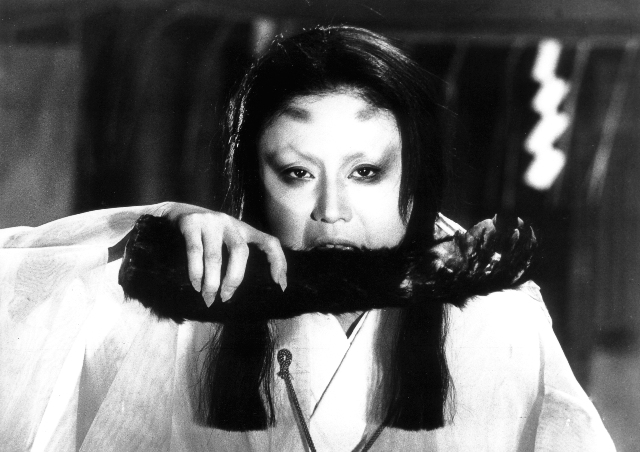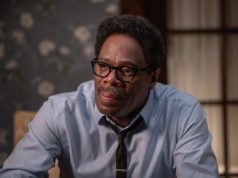Sad but not unexpected news comes to us from Japan: Yesterday, filmmaker Kaneto Shindô passed away just a month after his 100th birthday. Contrary to some news reports, Shindô was not the oldest currently active filmmaker. His last film (Postcard) came out in 2010, but Portuguese filmmaker Manoel de Oliveira released The Strange Case of Angelica last year, the year that he turned 103. Postcard capped Shindô’s prolific career, which stretched back to the 1940s and was interrupted by World War II, when the filmmaker fought in the Japanese Navy, serving in a 100-member squadron of whom 94 were killed. Not unlike many Japanese, Shindô remained haunted by his survival, as well as by the atomic bomb that dropped on his native Hiroshima.
It just so happens that I’ve been watching Shindô’s movies recently, specifically the two black-and-white horror films he made in the 1960s — both set in feudal Japan — that form a large part of his reputation. His 1964 film Onibaba is about a drafted soldier’s mother and wife who live in the marshy countryside outside Kyoto. Left without the man who’s supposed to provide for them, they’re so poor and hungry that they’ve taken to murdering passing samurai (by luring them into a Burmese tiger trap) for their food, cash, and valuables. When the younger woman (Jitsuko Yoshimura) falls in love with a potential mark (Kei Satô), her mother-in-law tries to keep control of her by using a mask to pose as a demon and scaring the younger woman from venturing out at night to meet her samurai lover. And then things get pretty weird.
The film was shot in an actual marsh with reeds taller than the actors. By all accounts, the experience of shooting the movie was hellish, taking place outdoors during one of the hottest summers on record, with cast and crew being constantly attacked by mosquitoes. This enhances the movie; you can feel the oppressive heat even if you don’t see the sweat beading up on the actors’ faces. This gritty film’s characters are ruled by basic animal needs. The opening sequence ends with the two women killing their latest victim, and they stand over the man’s body devouring the cooked rice that he was carrying. They’re neither feeling guilt over the murder nor tasting the food; they’re eating because they’ll die if they don’t. Later on, when the daughter-in-law has sex with the samurai warrior, it’s an act of pure lust and desire.
The realism plays well off the supernatural elements that come later. When the mother-in-law makes her first appearance as the demon, we know that it’s the older woman behind the mask, yet it’s still terrifying, as she seems to float above those swaying reeds, with the wind rippling her clothes. I don’t want to give away how the movie ends, but it’s a poetically hinky conclusion that’s handled in realistically flickering lamplight, and it’ll stick with you.
Shindô made Kuroneko four years later, and even though it’s also about a mother-in-law/daughter-in-law pair who kill samurai, it’s governed by a completely different aesthetic. Instead of the realism of Onibaba, this one is heavily influenced by Noh and Kabuki drama, and it’s intensely beautiful. The women here are raped and murdered by a pack of starving samurai, who burn their house to the ground. (This is a pattern in Shindô films — the samurai are always scuzzy mercenaries rather than heroes.) The women live on as vengeful ghosts who tear the throats out of passing samurai as retribution. The local warlord sends a newly minted war hero (Kichiemon Nakamura) to investigate, a man who just happens to be the son and husband of the two women. The movie’s title translates as “black cat,” and the women can take the form of cat spirits, which manifest themselves as unsettling shadows behind the hero when he goes to meet them. By the way, anime fans should not confuse this Kuroneko with this similarly named character or this one.
My favorite element here is the intentionally stagey set that represents the women’s house. The women haunt the site of their old house (which is nothing but ashes), but when their samurai victims go there, they see a grand estate belonging to a rich person. What we see is a nearly bare stage with exposed planks and billowing cloths representing the walls. The expressionistic lighting further heightens the sense of unreality. At one point when the women are alone, they sit on elevated black platforms against a black background, giving the appearance that they’re levitating. This is a great, evocative piece of set design by art director Takashi Marumo.
Nobuko Otowa plays the mother-in-law in both films, which benefit greatly from her presence. She was the director’s mistress for many years, becoming his wife only after his first wife died, and she acted in all but the last one of his 41 fiction films. She was a powerful performer, able to switch between ordinary characters and supernatural ones without missing a beat. In addition to all his visual gifts, Shindô had a sure hand with actors, directing Nakamura to a terrific performance in Kuroneko, whose characters goes from lowly battlefield grunt to dashing hero to raving maniac.
Shindô made more than just period horror films, some of them contemporary pieces examining social issues (like The Naked Island, the 1960 movie which made his international reputation) and documentaries (including one about his mentor, Kenji Mizoguchi). The horror films, too, are shot through with explorations of poverty and women’s issues. Yet they’re best appreciated as exquisite ballets of savagery, eroticism, and surpassing beauty. They are available on DVD, and now that the man is gone, you might want to pick one up and see what he was about.












